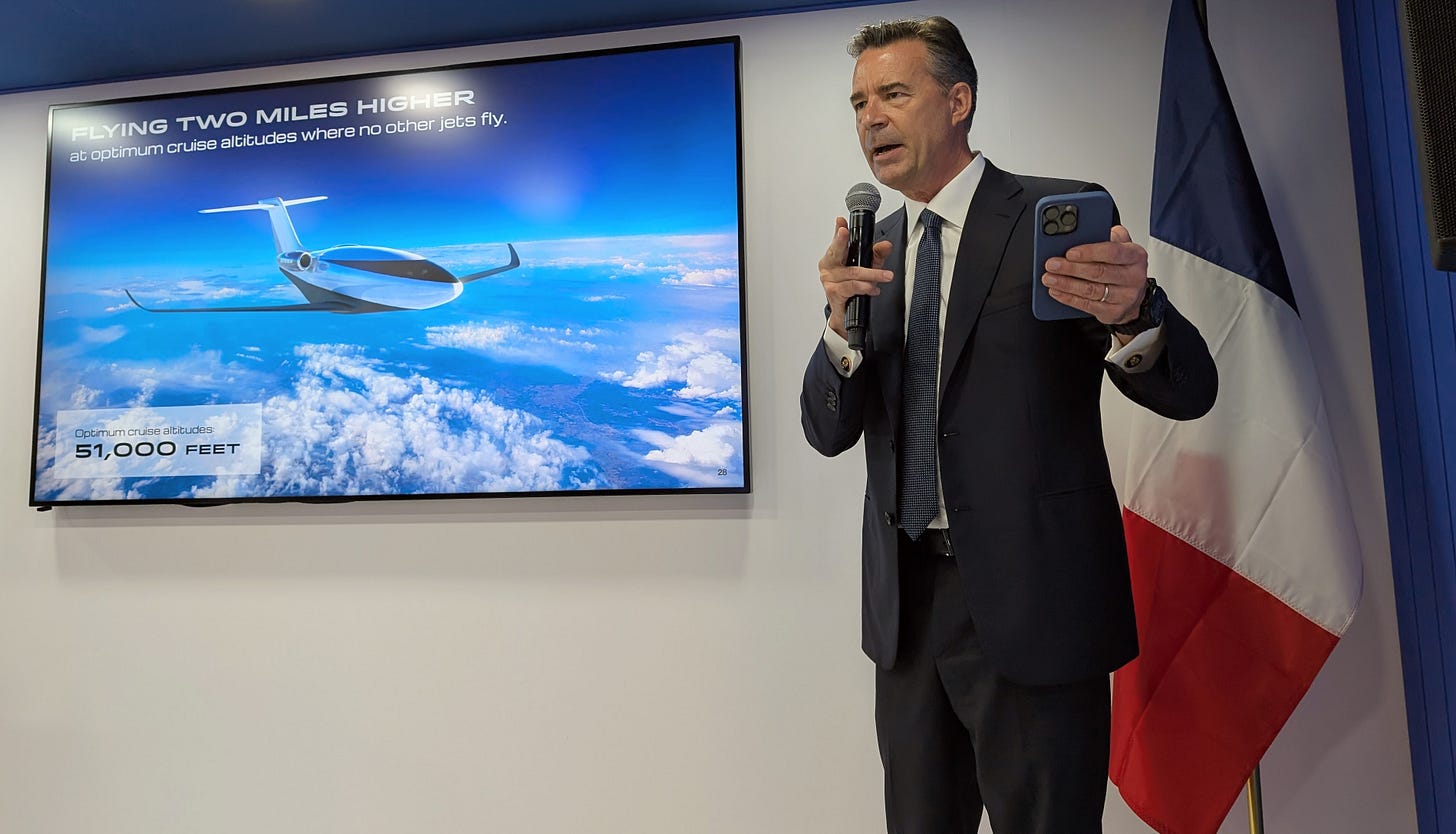Otto Aviation claims 'laminar flow' business jet delivers dramatic climate impact reduction
At Paris Air Show 2025, Otto Aviation unveiled the Phantom 3500, a business jet that promises to slash both emissions and contrail impact.
Texas-based Otto Aviation made a bold pitch to aviation industry leaders at this year’s Paris Air Show, revealing the Phantom 3500, a 'laminar flow '- based business jet that promises dramatic reductions in both fuel consumption and climate impact.
The company's claims are striking: a 61% reduction in fuel burn, a 92% drop in CO2 emissions when using sustainable aviation fuel (SAF), and a 90% cut in contrail formation due to its unusually high cruise altitude of 51,000 feet.
When combined, CEO Paul Touw said, these impacts deliver "over 97% total global warming force reduction."
"Our goal isn't just to switch fuels, it's to fundamentally reduce the energy needed for flight in the first place," said Touw. "That's the only way we reach net-zero without waiting for the fuel supply chain to catch up."
Laminar flow breakthrough
Unlike the turbulent flow that dominates most commercial aircraft designs, laminar flow involves smooth, streamlined airflow across the aircraft's surface.
This significantly reduces drag. According to Touw, viscous drag accounts for over 55% of total aircraft drag. Otto Aviation claims its Phantom 3500 achieves laminar flow across 87% of the airfoil and fuselage, something never before done at transonic speeds.
The result is a 35% reduction in drag and a cascade of knock-on effects: smaller engines, lighter structures, and less fuel needed to carry less fuel. Otto calls this the "virtuous cycle" of laminar design.
Crucially, the aircraft has already undergone slow-speed and transonic testing at the European Transonic Wind Tunnel (ETW), with results reportedly within 1% of performance predictions.
Dealing with 'the other half of aviation's climate problem'
As well as CO2, Otto targets contrails, the icy clouds formed by aircraft exhaust at high altitudes. According to a number of academic studies, contrails account for more than half of aviation's total global warming impact.
The Phantom 3500 flies above the typical contrail-forming band of 33,000–39,000 feet. By operating at 51,000 feet, Otto claims a 90% reduction in contrail formation, tackling what Touw calls "the other half of aviation's climate problem."
"Most of the industry ignores contrails because there's no clear regulatory pressure - yet," said Touw. "But we think the science is clear, and regulators will catch up."
Quiet funding, big backing
Despite Otto flying under the radar compared to other startups, Otto has raised significant sums of money — $170 million privately and over $515 million in incentives from the State of Florida and the City of Jacksonville to build its production base at Cecil Airport in the State.
That puts Otto in a rare club. According to Dealroom data last year, only five sustainable aviation firms (outside of eVTOLs) had raised over $100 million as of early 2024.
Flight testing is expected to begin in 2027, with certification and entry into service in 2030. Touw said Otto plans to produce 1,600 aircraft by 2040 across three models. One-third of those units, the company says, are already spoken for.
Market fit and manufacturing advantage
Otto's pitch centres on making sustainability profitable rather than costly. With a projected price of $18 million, 30% below similar super-midsize jets, and 50% lower operating costs, the company aims to win on both climate and commercial metrics.
The company says that the fuel efficiency translates to dramatic operational savings: the Phantom 3500 burns approximately 115 gallons per hour compared to 300 gallons for a comparable aircraft.
"One of the biggest inhibitors of SAF is the fact that it's so much more expensive," Touw noted. "With our technology you're actually reducing the cost so you get sustainability at a discount."
Otto also emphasised its advanced carbon-composite manufacturing process, which borrows techniques from stealth aircraft production. This enables smoother surfaces and lower labour and defect costs, an important piece of the cost advantage puzzle.
Notably, Otto had previously announced a collaboration with ZeroAvia to explore hydrogen-electric propulsion around 2022. That plan has since been shelved.
"We think this is a much better approach," said Touw when asked about the shift away from hydrogen. The company now believes that minimising energy requirements before tackling fuel sources is the superior strategy.
Otto is now part of a growing group of companies betting on completely reimagining and redesigning aircraft to deliver both economic and environmental gains in tandem.
JetZero, featured in our new book "Sustainability in the Air: Volume Two" is targeting the other end of the market with its blended wing body design aiming for 200-seat commercial aircraft. Both represent a departure from the industry's traditional approach of incremental improvements to existing designs.
A new benchmark in business aviation?
The Phantom 3500 is still years from first flight, and much hinges on whether Otto can execute its vision in real-world operations. But if its performance claims hold up, the company may have delivered a real and credible challenge to the slow march of incrementalism in business aviation.
In a field where big promises and slow timelines are common, Otto's quiet confidence and physics-first approach may prove its greatest asset — or its biggest test.





